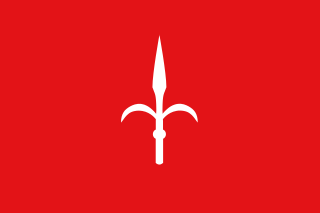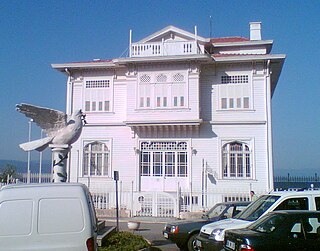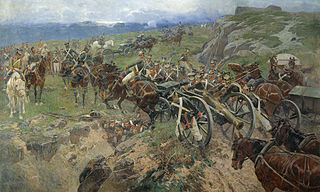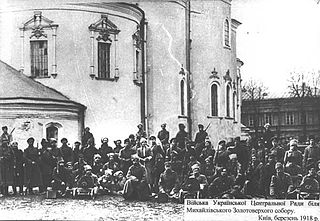
The Treaty of Versailles was a peace treaty signed on 28 June 1919. As the most important treaty of World War I, it ended the state of war between Germany and most of the Allied Powers. It was signed in the Palace of Versailles, exactly five years after the assassination of Archduke Franz Ferdinand, which led to the war. The other Central Powers on the German side signed separate treaties. The United States never ratified the Versailles treaty and made a separate peace treaty with Germany. Although the armistice of 11 November 1918 ended the actual fighting, it took six months of Allied negotiations at the Paris Peace Conference to conclude the peace treaty. Germany was not allowed to participate in the negotiations—it was forced to sign the final result.

The Treaty of Brest-Litovsk was a separate peace treaty signed on 3 March 1918 between Russia and the Central Powers, that ended Russia's participation in World War I. The treaty was signed at German-controlled Brest-Litovsk, after two months of negotiations. The treaty was agreed upon by the Russians to stop further invasion. As a result of the treaty, Soviet Russia defaulted on all of Imperial Russia's commitments to the Allies and eleven nations became independent in eastern Europe and western Asia. Under the treaty, Russia lost all of Ukraine and most of Belarus, as well as its three Baltic republics of Lithuania, Latvia, and Estonia, and these three regions became German vassal states under German princelings. Russia also ceded its province of Kars in the South Caucasus to the Ottoman Empire. According to historian Spencer Tucker, "The German General Staff had formulated extraordinarily harsh terms that shocked even the German negotiator." Congress Poland was not mentioned in the treaty. When Germans later complained that the 1919 Treaty of Versailles against Germany was too harsh on them, the Allied Powers responded that it was more benign than the terms imposed by the Brest-Litovsk treaty.

The Free Territory of Trieste was an independent territory in Southern Europe between northern Italy and Yugoslavia, facing the north part of the Adriatic Sea, under direct responsibility of the United Nations Security Council in the aftermath of World War II. For a period of seven years, it acted essentially as a free city.

The Egypt–Israel peace treaty was signed in Washington, D.C., United States on 26 March 1979, following the 1978 Camp David Accords. The Egypt–Israel treaty was signed by Egyptian president Anwar Sadat and Israeli prime minister Menachem Begin, and witnessed by United States president Jimmy Carter.

The Moscow Peace Treaty was signed by Finland and the Soviet Union on 12 March 1940, and the ratifications were exchanged on 21 March. It marked the end of the 105-day Winter War, upon which Finland ceded border areas to the Soviet Union. The treaty was signed by Vyacheslav Molotov, Andrei Zhdanov and Aleksandr Vasilevsky for the Soviet Union, and Risto Ryti, Juho Kusti Paasikivi, Rudolf Walden and Väinö Voionmaa for Finland. The terms of the treaty were not reversed after the dissolution of the Soviet Union. The Karelian question refers to the debate within Finland over the possible reacquisition of this ceded territory.

In the 1667 to 1668 War of Devolution, France occupied large parts of the Spanish Netherlands and Franche-Comté, both then provinces of the Holy Roman Empire. The name derives from an obscure law known as the Jus Devolutionis, used by Louis XIV of France to claim that these territories had "devolved" to him by right of marriage to Maria Theresa of Spain.

The Treaty of Bucharest (1918) was a peace treaty between Romania and the opposing Central Powers following the stalemate reached after the campaign of 1917. This left Romania isolated after Russia's unilateral exit from World War I.

This timeline of events preceding World War II covers the events of the interwar period (1918–1939) after World War I that affected or led to World War II.

The Armistice of Mudanya was an agreement between Turkey on the one hand, and Italy, France, and Britain on the other hand, signed in the Ottoman town of Mudanya, in the province of Bursa, on 11 October 1922. The Kingdom of Greece acceded to the armistice on 14 October 1922.

The Soviet occupation of Romania refers to the period from 1944 to August 1958, during which the Soviet Union maintained a significant military presence in Romania. The fate of the territories held by Romania after 1918 that were incorporated into the Soviet Union in 1940 is treated separately in the article on Soviet occupation of Bessarabia and Northern Bukovina.

The 1804–1813 Russo-Persian War was one of the many wars between the Persian Empire and Imperial Russia, and began like many of their wars as a territorial dispute. The new Persian king, Fath Ali Shah Qajar, wanted to consolidate the northernmost reaches of his kingdom—modern-day Georgia—which had been annexed by Tsar Paul I several years after the Russo-Persian War of 1796. Like his Persian counterpart, the Tsar Alexander I was also new to the throne and equally determined to control the disputed territories.
The Treaty of Hampton Court was signed on 22 September 1562 between Queen Elizabeth and Huguenot leader Louis I de Bourbon, prince de Condé. The treaty was concluded by François de Beauvais, Seigneur de Briquemault. Based on the terms of the accord, 3000 English troops were summoned to occupy Le Havre and Dieppe. Moreover, Queen Elizabeth promised to provide economic aid to the Huguenots. Once peace was restored in France, Elizabeth refused to withdraw her troops, stating that she had taken Le Havre not for religious reasons but to indemnify her for the loss of Calais, which was rightfully hers. The regent of France, Catherine de' Medici sent both Catholic and Huguenot troops against Le Havre, which surrendered on 28 July 1563. Feeling betrayed by the Huguenots, Elizabeth never trusted them again. This is evident when in 1572, Catherine de Medici ordered the killing of the Protestant Coligny. This resulted in 3000 Protestants being killed in what is known as the Massacre of St Bartholomew's Day. Elizabeth was urged to send support to the French Huguenots but refused.

The Armistice of Salonica was signed on 29 September 1918 between Bulgaria and the Allied Powers in Thessaloniki. The convention followed a request by the Bulgarian government for a ceasefire on 24 September.

The Treaty of Breslau was a preliminary peace agreement signed on 11 June 1742 following long negotiations at the Silesian capital Wrocław by emissaries of Archduchess Maria Theresa of Austria and King Frederick II of Prussia ending the First Silesian War.

The Treaty of Florence, which followed the Armistice of Foligno, brought to an end the war between the French Republic and the Kingdom of Naples, one of the Wars of the French Revolution. Forced by the French military presence, Naples ceded some territories in the Tyrrhenian Sea and accepted French garrisons to their ports on the Adriatic Sea. All Neapolitan harbours were closed to British and Ottoman vessels.

The Treaty of Brest-Litovsk was an exclusive protectorate treaty signed on 9 February 1918 between the Central Powers and the Ukrainian People's Republic, recognizing the latter's sovereignty. It was part of the same negotiations that took place in Brest-Litovsk, Grodno Governorate that also produced the separate treaty of the same name between the Russian Soviet Federative Socialist Republic and the Central Powers on 3 March 1918.

The Province of Pomerania was a province of Brandenburg-Prussia, the later Kingdom of Prussia. After the Thirty Years' War, the province consisted of Farther Pomerania. Subsequently, the Lauenburg and Bütow Land, Draheim, and Swedish Pomerania south of the Peene river were joined into the province. The province was succeeded by the Province of Pomerania set up in 1815.

The Treaty or Peace of Saint-Germain-en-Laye of 19 June (OS) or 29 June (NS) 1679 was a peace treaty between France and the Electorate of Brandenburg. It restored to France's ally Sweden her dominions Bremen-Verden and Swedish Pomerania, lost to Brandenburg in the Scanian War. Sweden ratified the treaty on 28 July 1679.
The Treaty of Constantinople was a treaty between the Ottoman Empire and the Kingdom of Greece signed on 4 December 1897 following the Greco-Turkish War (1897).

The Ukrainian–Soviet War is the term commonly used in post-Soviet Ukraine for the events taking place between 1917–21, nowadays regarded essentially as a war between the Ukrainian People's Republic and the Bolsheviks. The war ensued soon after the October Revolution when Lenin dispatched Antonov's expeditionary group to Ukraine and Southern Russia.


















